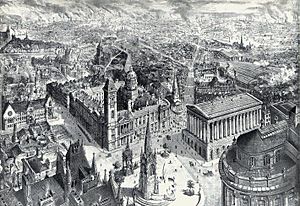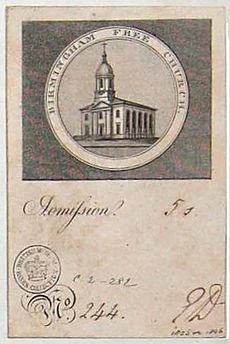Christ Church, Birmingham facts for kids
Quick facts for kids Christ Church(Birmingham) |
|
|---|---|
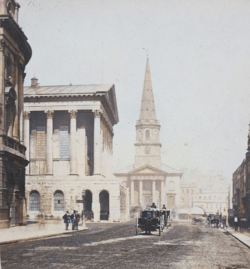
Colorised stereograph of Paradise Street, showing Christ Church and the Town Hall c.1860–1880
|
|
| 52°28′47″N 1°54′08″W / 52.479671°N 1.902331°W | |
| OS grid reference | SP067868 |
| Location | Birmingham |
| Country | England |
| Denomination | Church of England |
| Architecture | |
| Architect(s) |
|
| Groundbreaking | 1805 |
| Completed | 1813 |
| Construction cost | £26,000 |
| Closed | 1897 |
| Demolished | 1899 |
| Specifications | |
| Capacity | 1500–1600 people |
| Length | 140 feet (43 m) |
| Width | 71 feet (22 m) |
| Administration | |
| Parish |
|
| Diocese | Worcester |
| Province | Canterbury |
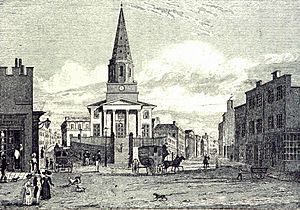
Christ Church, also known as the Free Church, was a big church in Birmingham, England. It was part of the Church of England. Today, the spot where the church once stood is a major part of Victoria Square in the city.
Contents
Building Christ Church
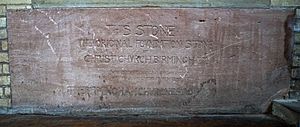
The land for Christ Church was given by William Phillips Inge. It was located where Ann Street and New Street met. The church was designed by either Charles Norton or William Hollins, both architects worked on the building.
Funding and Foundation
People helped pay for the church by donating money. Even King George III gave a large sum of £1,000. The first stone was laid on July 22, 1805, by George Legge, 3rd Earl of Dartmouth. The King had planned to do it himself but was too ill.
Design and Features
The church was built from stone in a Classical style. It had large Doric columns at the front. Inside, all the seats on the ground floor were free to use. This is why it became known as the 'Free Church'. The church was officially opened on July 6, 1813, by James Cornwallis, 4th Earl Cornwallis, who was the Bishop of Lichfield.
The tall square tower was finished in 1814. It had an eight-sided bell tower and a Gothic spire. The first plan was to have a dome, but changes were made due to money delays. The whole building was finished in 1816, and a clock was added a year later. An organ was installed by Thomas Elliot. The church also had many underground burial vaults, some several stories deep. One of these vaults held the remains of John Baskerville. The total cost to build the church was about £26,000.
A Funny Saying
Because of the church's unique seating arrangement, a funny saying became popular:
- "Our churches and chapels we generally find
- Are the places where men to the women are joined;
- But at Christ Church, it seems, they are more cruelhearted,
- For men and their wives go there and get parted."
This joke meant that because men and women sat on different sides, couples would be "parted" during the service.
Church Community
Even though it was first meant to be a smaller part of St Philip's church, Christ Church started keeping its own records in 1817. By 1865, the church had so many people attending that it became its own parish. This new parish took areas from both St Martin's and St Philip's parishes.
Church Leaders
- John Hume Spry (1813–1824)
- Archdeacon George Hodson (1824–1832)
- John George Breay (1832–1840)
- George Lea (1840–1864)
- Charles Marson (1864–1871)
- Albert Workman (1871–1881)
- Rev Prebendary E.R. Mason (1881–1888)
- Rev Prebendary C.B. Willcox (1889–1897)
Organists
- Thomas Munden (1818–1856)
End of Christ Church
The church building and its land were sold in 1897. The money from the sale was used to build St Agatha's Church, Sparkbrook. Christ Church was torn down in 1899. Part of its old parish area was then given to St Barnabas' Church, Birmingham.
In 2021, a new church called Christ Church Birmingham started. It does not have a fixed building but serves communities across the city today.
Notable Burials
Some important people were buried or had their remains placed in the vaults under Christ Church:
- John Baskerville (1707–1775): A famous English businessman, known for his printing and for creating the Baskerville typeface.
- Joseph Frederick Ledsam (1791–1862): A local leader who was a Deputy Lord Lieutenant of Warwick and a deputy chairman of the London and North Western Railway.


